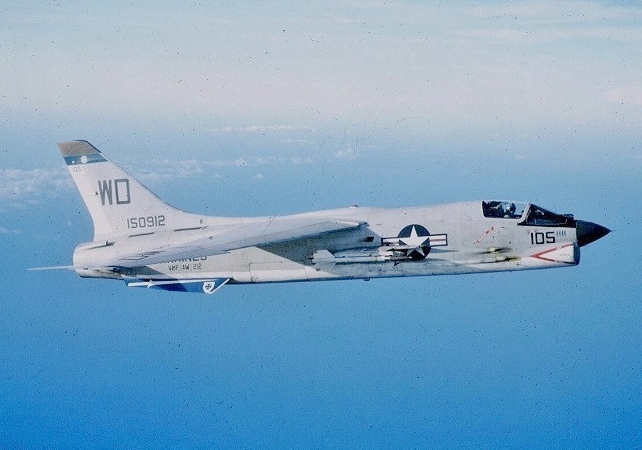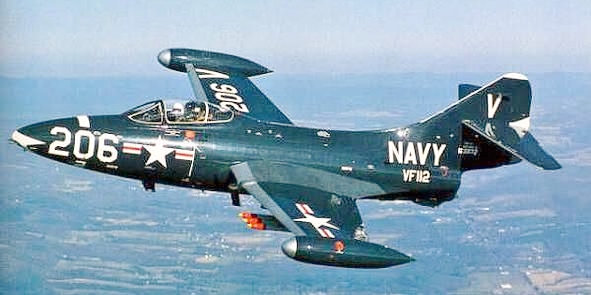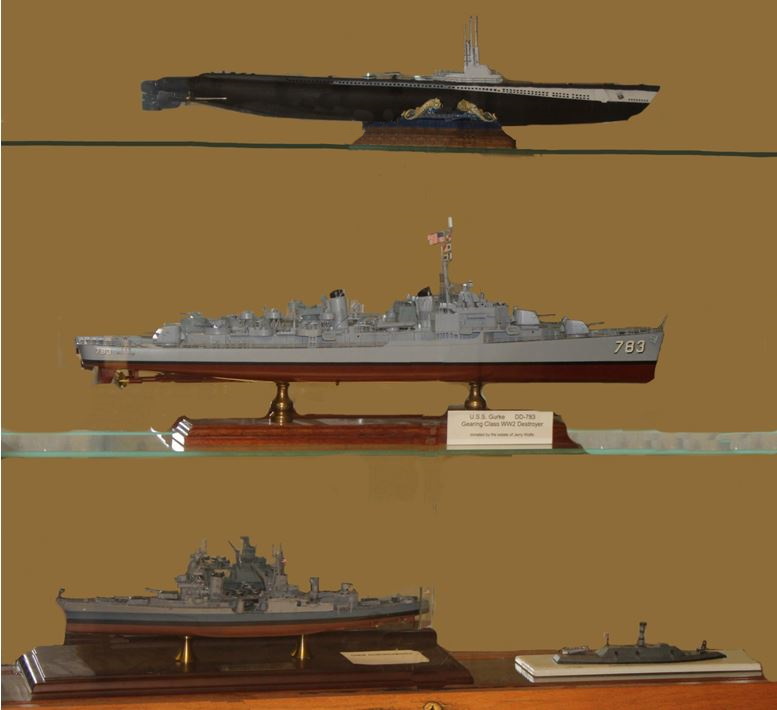- Top Shelf (L to R)
F-105 Republic (Thunderchief) - Vietnam War USAF supersonic jet fighter bomber aircraft

The Republic F-105 Thunderchief was an American produced supersonic fighter used by the US Air Force. It was originally designed as a low altitude high speed penetration aircraft and could carry a single nuclear bomb internally. The F-105 was very large and was capable of carrying a larger bomb load than a WWII era B-17. When first introduced in 1958, it was the largest single seat single engine combat aircraft in history. It could exceed the speed of sound at sea level and reach speeds of Mach 2 at high altitude. The F-105 carried out the majority of strike missions over Vietnam during the early phases of the war. The maximum bomb load was 14,000 pounds. Its most advantageous flight characteristic was its high speed. It was less maneuverable than Mig fighter aircraft sent to interdict it. A special version of the F-105 was produced known as the Wild Weasel. It was equipped with special electronics systems for radar detection and jamming and was used for suppression of enemy aircraft defense systems. The F-105 had a maximum speed of 1390 mph, a range of 2,200 miles and a service ceiling 48,000. In addition to its bomb bay and external hardpoints for carrying bombs, it was armed with a 20 mm Vulcan 6-barreled Gatling Gun.
F-102 A Delta Dagger USAF Interceptor Aircraft

The Delta Dagger was an American interceptor aircraft introduced into service with the US Air Force in 1956. It was designed to intercept and defend against the Soviet Strategic Bomber Fleets. The F-102 was the USAF's first supersonic delta wing interceptor. It had an internal weapons bay for carrying guided missiles and rockets. The F-102 served in the Vietnam War and was used for fighter patrols and bomber escort. B52 bombers participating in operation "Arc Light" were escorted by the F-102. A total of 1,000 were built. The F-105 remained in service until 1979.
- 2nd Shelf (L to R)
F-7 Vought F7U Cutlass US Navy Fighter/Fighter Bomber:

The F-7 Vought Cutlass was a US Navy carrier based fighter and fighter bomber. It was a Cold War ear aircraft introduced into service in 1951. Its tailless design is somewhat unique and distinctive and was claimed to have been based on German aerodynamic research. The cockpit is placed well forward offering good visibility for the pilot. The aircraft had all hydraulic controls which provided artificial feedback to the pilot so the pilot could feel aerodynamic forces acting on the aircraft during flight. The unusual design gave the aircraft some troubling handling characteristics but the ability to perform rolls three times faster than other similar aircraft. Several were involved in accidents and the aircraft was eventually removed from service in 1959. A total of 320 were built.
F-4 B Phantom US Navy Long Range Fighter Bomber/ Interceptor

The F-4 Phantom is an twin engine twin seat long range interceptor fighter bomber produced by MCDonnell Douglass. It was designed as part of an effort to create a single unified fighter aircraft for all branches of service. It was first introduced into service in 1961 and is still in limited service today. Between 1958 through 1981, over 5200 were built making it the most produced American supersonic military aircraft in history. The F-4 has a top speed of Mach 2.2 and can carry an 18,000 pound bomb load. The F-4 earned an iconic role as air superiority fighter during the Vietnam War and was heavily employed by the US Marines, USAF and the US Navy. The F-4 remained a principal component of US Military air power through the 1970s and 80s. The F-4 B was equipped with Westinghouse APQ-72 radar a Texas Instruments AAA-4 Infrared search and track pod under the nose, an AN/AJB-3 bombing system and powered by J79-GE-8,-8A and -8B engines. The Phantom was especially capable and earned many records including a world record altitude of 98,000 ft, a transcontinental flight in 2 hours 47 minutes, and a speed record of 1,600 mph. The F-4 has a bomb load capacity of over 18,000 pounds. The high speed of the F-4 was its strong point. It was less agile than contemporary Mig aircraft. Phantoms performed air superiority and ground attack roles in Vietnam and were also used for bombing missions over North Vietnam and Laos. Versions of the F-4 Phantom were also equipped to fly Wild Weasel missions against North Vietnamese air defense installations. Despite its powerful radar, high speed and acceleration and firepower, the F-4 was seriously challenged by the Mig-21 in aerial combat. The Phantom has served with many nations around the world including Australia, Germany, Greece, Iran, Israel, Japan and Turkey. Over 5,000 have been built.
F-8 Vought Crusader Air Superiority Aircraft

The F-8 Vought was a single engine supersonic carrier based air superiority aircraft first introduced in 1957. The Crusader was the last American made fighter aircraft primarily armed with guns instead of missiles although it was armed with both. In Vietnam, the Crusader earned a reputation for achieving the highest kill ratio of any fighter aircraft 19:3. The Crusader was the first USAF fighter to engae in aerial combat with enemy aircraft from the Vietnam Peoples Air Force. A version of the Crusader, the RF8A was modified to perform reconnaissance missions. These were used to fly very low level reconnaissance mission over Cuba and obtained evidence of the installation of Soviet MRBMs.
- 3rd Shelf (L to R)
T-38 Talon Northtrop USAF Supersonic Trainer

The T-38 Talon is a supersonic trainer jet aircraft built by Northtrop Corporation. When introduced, it was the world's first supersonic trainer. The T-38 is used primarily for training of USAF pilots to prepare for flying aircraft such as the B-52, U2, SR-71, F16 and the B1B Lancer. The T-38 was first introduced in 1961, has been in service for over 50 years and is still in service today. It is estimated that over 50,000 pilots have been trained on this aircraft. The T-38 is characterized by its long chord low wing design with single vertical stabilizer, and tricycle landing gear configuration. The T-38 is powered by two turbojet engines and seats two including the student and instructor in tandem. In addition to the USAF and NASA, the T-38 is also operated by the German Air Force, the Portuguese Air Force, the Republic of China Air Force, and the Turkish Air Force. Over 1,100 have been built.
F-16 Fighting Falcon General Dynamics USAF Multi-role Fighter

The F-16 is a multi-role fighter aircraft developed by General Dynamics for the USAF. It was first introduced into service in 1978 as air superiority fighter. It is the worlds most numerous fixed wing military aircraft with 4,600 produced. The F-16 was designed to fulfill a NATO requirement to replace the F104G and a USAF requirement to replace the F105 and F4 Phantom jet aircraft. The design was chosen from a competition including the French Mirage F1M-53, the Anglo-French SEPECAT Jaguar, the Northrop P-530 Cobra, and the Saab 37E Eurofighter. The F-16 is small and lightweight but has sophisticated avionics including a Head Up Display and Westinghouse AN/APG-66 Fire Control Radar and employs advanced aerodynamic engineering. Its design is optimized for high agility combat. The F-16 is the first the first jet aircraft to maneuver at 9Gs and has a maximum speed of over Mach 2. Its frame-less bubble canopy window offers excellent visibility. It is armed with a 20 mm M61 Vulcan cannon and can carry a variety of munitions on external mounts. The F-16 is designed to be inexpensive and simple to maintain. The F-16 uses a cropped delta-wing configuration, an underslung air intake and tricycle landing gear. The F-16 is the first jet aircraft to be designed to be slightly aerodynamically unstable in order to obtain maximum maneuverability and employs a fly-by-wire flight control system which the pilot is completely dependent upon to fly the aircraft. The F-16 has been heavily employed by the USAF in Operation Desert Storm and during the War in Afghanistan, by the Pakistan Air Force against the Indian Air Force, by Turkey, in its action against Kurdish fighters, and the Israeli Air Force, which used F-16s in its strike against nuclear facilities in Baghdad developed by Saddam Hussein. The F-16 is still in active service after 46 years.
T-33 Shooting Star Lockheed Subsonic Trainer

The T-33 is a subsonic jet trainer aircraft produced by Lockheed in 1948. Its design was based on the P-80 also built by Lockheed. Some T-33 aircraft were actually used by the Cuban Air Force during the Bay of Pigs Invasion. It was phased out of service in the early 1960s and replaced by the T-38 Talon. A total of over 6,500 T-33 aircraft were produced. The T-33 has served with over 30 nations and is still in use as trainer aircraft today.
- 4th Shelf (L to R)
Mig -17 Soviet Fighter

The Mig 17 is a Soviet made subsonic jet fighter aircraft first introduced into service in 1952. Its design evolved from the earlier Mig 15. The Mig 17 was one of the most capable of the early transonic fighter jet aircraft. The Mig 17 proved to be very effective in engagements against faster but less maneuverable aircraft. The Mig 17 was designed to intercept straight and level flying enemy bombers as opposed to air-to-air dogfighting. It was effective against slower heavily loaded American fighter bombers such as the Boeing P-50 and the Convair B-36. Mig 17 aircraft were provided to the Vietnam People's Air Force by the Soviet Union. North Vietnamese pilots were trained in the People's Republic of China and the Soviet Union. The Mig 17 was also used as fighter bomber and was used to attack US Navy warships in 1971. The Mig 17 proved to be a worthy opponent in the air war over Vietnam and successfully engaged F105 Thunderchiefs, F-4 Phantoms, and A-4 Skyhawks. The Mig 17 was the standard fighter aircraft for over 20 Warsaw Pact countries and is still in service today.
Gruman F-9F Panther Carrier Based Fighter

The F9F was produced by Grumman and first introduced into service in 1947. The F9F was the first jet fighter produced by Grumman and was the US Navy's first carrier based jet fighter. The F9F was used extensively by the US Navy and Marine Corps during the Korean War as ground attack aircraft and jet fighter. The F9F flew over 78,000 sorties in the Korean War for the US Navy. The F9F had a reputation for being very rugged and reliable and able to withstand heavy damage in combat. The F9F was withdrawn from front line service in 1956.
F-80 Shooting Star Lockheed USAF Fighter

The P-80 Shooting Star was the first jet fighter used by the USAF. It was designed and built by Lockheed in 1943 after an extremely brief development period. Its most distinguishable characteristic are its straight wings similar to earlier propeller driven aircraft. It was the first jet fighter to have its engine located in the fuselage. The impetus for development of the P-80 was intelligence gathered by the Allies of the German Messerschmitt Me262 jet aircraft introduced in 1943. The development of the P-80 was highly secret and carried out by the Skunk Works team which produced a prototype air frame in just 143 days. The P-80 was the first turbo jet powered aircraft to exceed 500 mph in level flight. The P-80 was first introduced into service in late 1944 and saw very limited action during WWII. The P-80 was employed in Europe for Operation Fox Able during the Berlin Blockade Crisis. The P-80 was first used in aerial combat during the Korean War. It was during this time that it was discovered that the swept wing design of the Mig 15, influenced by WWII German aviation research, was superior to the straight wing design of the P-80. The P-80 was eventually replaced by the more advanced F-86 Sabre.
F-86 Sabre North American Aviation Fighter

The F-86 Saber is a fighter aircraft produced by North American Aviation. It was introduced in 1949 and was the first American swept wing fighter. The F-86 is considered to be one of the best fighter aircraft of the Korean War era. It is the most produced American jet fighter with a total of 9.860 produced. The F-86 is the first American aircraft design heavily influenced by German aerodynamic flight research data seized after the end of WWII. The F-86 was designed to serve as fighter-bomber and fighter-interceptor. The fighter-bomber variant of the F-86 could carry up to 2,000 pounds of bombs.
- 5th Shelf (L to R)
F-82 Twin Mustang North American Aviation Fighter Escort

The F-82 Twin Mustang is a fighter aircraft produced by North American Aviation and introduced into service in 1946. Its design was based on the earlier P-51 Mustang and was intended to operate as a long range fighter escort. Early versions of the aircraft were designed to accommodate two pilots that could alternate control of the aircraft. The piston engine P-82 had a longer range than fighter jet aircraft of this period. The dawning of strategic realities of the Cold War meant that USAF long range bombers needed escorts for bombing missions deep into Soviet territory. These missions required even longer ranges than scenarios of WWII. The F-82 had a range of 1,400 miles which could be extended with use of external fuel tanks. In 1947, a P-82 B made history when it flew non-stop from Hawaii to New York non-stop in 14 hours without refueling. The F-82 also had a service ceiling of 40,000 ft which allowed it to stay close with bomber aircraft it was intended to protect. Reconnaissance missions flown by the F-82 over South Korea were the first air combat missions of the Korean War. Although it performed well as fighter aircraft, the F-82 had a short service life as it was introduced at the dawning of the jet aircraft development. It was replaced Republic F-84 Thunderjet.
Fairey Firefly British Fighter Aircraft

The Fairey Firefly was a carrier operated fighter aircraft developed by British Fairey Aviation Company. The Fairey Firefly was first introduced into service in 1943. The Firefly supersceeded the earlier Fairey Fulmar also produced by Fairey Aviation. The Firefly was rendered obsolete by the arrival of newer jet aircraft and was retired from service in 1956. During its service life it was operated by air forces of Australia, Canada, India and the Netherlands. The Firefly was a low ing cantilever monoplane and was powered by a Rolls Royce Griffon liquid cooled piston engine. The aircraft had folding all-metal wings and an arrestor hook for carrier landing. The firefly was armed with four 20 mm cannons. Fairey Fireflys performed aerial reconnaisance during attacks on the German battleship Tirpitz. The Firefly was used in anti-submarne warfare and was the first British aircraft to overfly Tokyo. Over 1700 were produced.
Mig 29 Fulcrum Mikoyan Soviet Fighter

The Mikoyan Mig 29 (NATO Fulcrum) is a twin engine jet fighter aircraft. The Mig 29 was developed as air superiority aircraft in 1977 and introduced in 1982 primarily to counter the F-15 and F16. The Mig 29 also serves as multi-role fighter aircraft capable of serving a variety of purposes. The Russian Air Force is the largest operator of the Mig 29, but it is also in service with more than 30 nations around the world. The Mig 29 has a mid mounted swept wing configuration with swept tail planes and two vertical fins. It is interesting to note that the Mig 29 does not employ a fly-by-wire flight control system and is somewhat less maneuverable than similar aircraft equipped with fly-by-wire. Also, early versions of the Mig 29 was not equipped with Head Up display technology limiting situational awareness of pilots in aerial combat. India was the first international customer to receive exported Mig 29 aircraft. Over 1,600 have been produced. many have seen action in various conflict zones around the world including Kosovo, Iraq, India, Libya, Syria, and Sudan.
- 6th Shelf (L to R)
F-89 Scorpion Northtrup USAF Interceptor

The F-89 Scorpion was developed by Northtrop Corporation and introduced into service in 1950. The F-89 was the first American made jet powered interceptor aircraft. It was also one of the first USAF aircraft to employ guided missiles and was the first aircraft to carry the unguided air-to-air nuclear Genie rocket. The F-89 was initially designed to replace the P-61 Black Widow night fighter. Early prototypes were designed with swept wings, but performed poorly at low speeds, so the design was refitted with straight wings. The F-89 was armed with 6 20mm cannons and could carry 16 5-inch rockets or 3200 pounds of pounds. The wingtips were fitted with 300 gallon fuel tanks. The F-89 is the only aircraft that has fired a live Genie nuclear rocket. A total of 1050 F89 aircraft were produced.
F-84 Republic Thunderjet Fighter Bomber 
The F84 Thunderjet was an American made turbojet fighter-bomber aircraft introduced in 1947 intended to serve as replacement for the P-47 Thunderbolt. After design problems were solved in early models, the F84 became the primary strike aircraft of the USAF in Korea flying over 86,000 sorties. Over half of the F84 aircraft produced were operated by NATO countries. The F84 is known as the first fighter aircraft capable to perform in-flight refueling and the first fighter aircraft capable of carrying a nuclear weapon, the Mark 7 nuclear bomb. The USAF has claimed that 60% of all ground targets destroyed in the Korean War were hit by munitions carried by the F 84. Over 7,500 were produced before it was retired from active service in 1964.



